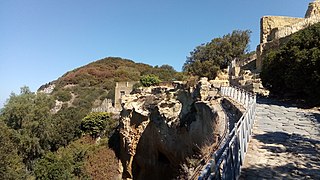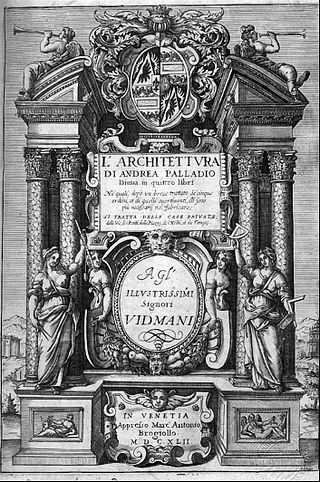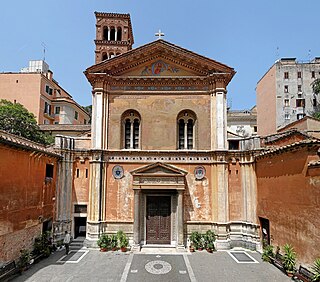
Tivoli is a town and comune in Lazio, central Italy, 30 kilometres north-east of Rome, at the falls of the Aniene river where it issues from the Sabine Hills. The city offers a wide view over the Roman Campagna.

Cumae was the first ancient Greek colony of Magna Graecia on the mainland of Italy and was founded by settlers from Euboea in the 8th century BCE. It became a rich Roman city, the remains of which lie near the modern village of Cuma, a frazione of the comune Bacoli and Pozzuoli in the Metropolitan City of Naples, Campania, Italy. The archaeological museum of the Campi Flegrei in the Aragonese castle contains many finds from Cumae.

The Domus Aurea was a vast landscaped complex built by the Emperor Nero largely on the Oppian Hill in the heart of ancient Rome after the great fire in 64 AD had destroyed a large part of the city.

The Pantheon is a former Roman temple and, since AD 609, a Catholic church in Rome, Italy. It was built on the site of an earlier temple commissioned by Marcus Vipsanius Agrippa during the reign of Augustus ; then, after the original burnt down, the present building was ordered by the emperor Hadrian and probably dedicated c. AD 126. Its date of construction is uncertain, because Hadrian chose not to inscribe the new temple but rather to retain the inscription of Agrippa's older temple.

The Esquiline Hill is one of the Seven Hills of Rome. Its southernmost cusp is the Oppius.

The Caelian Hill is one of the famous seven hills of Rome.

I quattro libri dell'architettura is a treatise on architecture by the architect Andrea Palladio (1508–1580), written in Italian. It was first published in four volumes in 1570 in Venice, illustrated with woodcuts after the author's own drawings. It has been reprinted and translated many times, often in single-volume format.

Hadrian's Villa is a UNESCO World Heritage Site comprising the ruins and remains of a large villa complex built around AD 120 by Roman emperor Hadrian near Tivoli outside Rome.

The Basilica of Santa Pudenziana is the eldest historical Roman Catholic basilica built in the fourth century. The original shrine building dates back from the second century and is dedicated to Saint Pudentiana, sister to Praxedes the Martyress and both daughters of Saint Pudens. It is one of the national churches in Rome designated for the Philippines and is both piously and culturally associated with the Filipino peoples. It is designated a Basilica by the privilege of immemorial status.

The Gardens of Sallust was an ancient Roman estate including a landscaped pleasure garden developed by the historian Sallust in the 1st century BC. It occupied a large area in the northeastern sector of Rome, in what would become Region VI, between the Pincian and Quirinal hills, near the Via Salaria and later Porta Salaria. The modern rione is now known as Sallustiano.

St. Gereon's Basilica is a German Roman Catholic church in Cologne, dedicated to Saint Gereon, and designated a minor basilica on 25 June 1920.

San Teodoro, informally known as San Toto, is an early medieval church in Rome dedicated to the martyr and warrior saint Theodore of Amasea. Its use was given to the Eastern Orthodox community of Rome by Pope John Paul II in 2004.

Vittorio Emanuele is a station on Line A of the Rome Metro. The station was inaugurated in 1980 and is sited underground, beneath Piazza Vittorio Emanuele II, which gives it its name, in the Esquilino rione.
The temple of Minerva Medica was a temple in ancient Rome, built on the Esquiline Hill in the Republican era, though no remains of it have been found. Since the 17th century, it has been wrongly identified with the ruins of a nymphaeum on a nearby site, on account of the erroneous impression that the Athena Giustiniani had been found in its ruins.

Domes were a characteristic element of the architecture of Ancient Rome and of its medieval continuation, the Byzantine Empire. They had widespread influence on contemporary and later styles, from Russian and Ottoman architecture to the Italian Renaissance and modern revivals. The domes were customarily hemispherical, although octagonal and segmented shapes are also known, and they developed in form, use, and structure over the centuries. Early examples rested directly on the rotunda walls of round rooms and featured a central oculus for ventilation and light. Pendentives became common in the Byzantine period, provided support for domes over square spaces.

The Temple of Claudius, also variously known as the Temple of the Divus Claudius, the Temple of the Divine Claudius, the Temple of the Deified Claudius, or in an abbreviated form as the Claudium, was an ancient structure that covered a large area of the Caelian Hill in Rome, Italy. It housed the Imperial cult of the Emperor Claudius, who was deified after his death in 54 AD.

The sanctuary of Maria Santissima della Rotonda, formerly known as Santa Maria Maggiore, is an important Marian sanctuary in Lazio, located in the city of Albano Laziale, in the province of Rome, in the Roman Castles area.





















